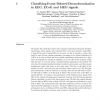Free Online Productivity Tools
i2Speak
i2Symbol
i2OCR
iTex2Img
iWeb2Print
iWeb2Shot
i2Type
iPdf2Split
iPdf2Merge
i2Bopomofo
i2Arabic
i2Style
i2Image
i2PDF
iLatex2Rtf
Sci2ools
DAGM
2006
Springer
2006
Springer
Classifying Event-Related Desynchronization in EEG, ECoG and MEG Signals
We present the results from three motor-imagery-based Brain-Computer Interface experiments. Brain signals were recorded from 8 untrained subjects using EEG, 4 using ECoG and 10 using MEG. In all cases, we aim to develop a system that could be used for fast, reliable preliminary screening in the clinical application of a BCI, so we aim to obtain the best possible classification performance in a short time. Accordingly, the burden of adaptation is on the side of the computer rather than the user, so we must adopt a machine-learning approach to the analysis. We introduce the required machine-learning vocabulary and concepts, and then present quantitative results that focus on two main issues. The first is the effect of the number of trials--how long does the recording session need to be? We find that good performance could be achieved, on average, after the first 200 trials in EEG, 75
DAGM 2006 | Image Processing | Performance | Possible Classification Performance | Required Machine-learning Vocabulary |
| Added | 22 Aug 2010 |
| Updated | 22 Aug 2010 |
| Type | Conference |
| Year | 2006 |
| Where | DAGM |
| Authors | N. Jeremy Hill, Thomas Navin Lal, Michael Schröder 0002, Thilo Hinterberger, Guido Widman, Christian Erich Elger, Bernhard Schölkopf, Niels Birbaumer |
Comments (0)

